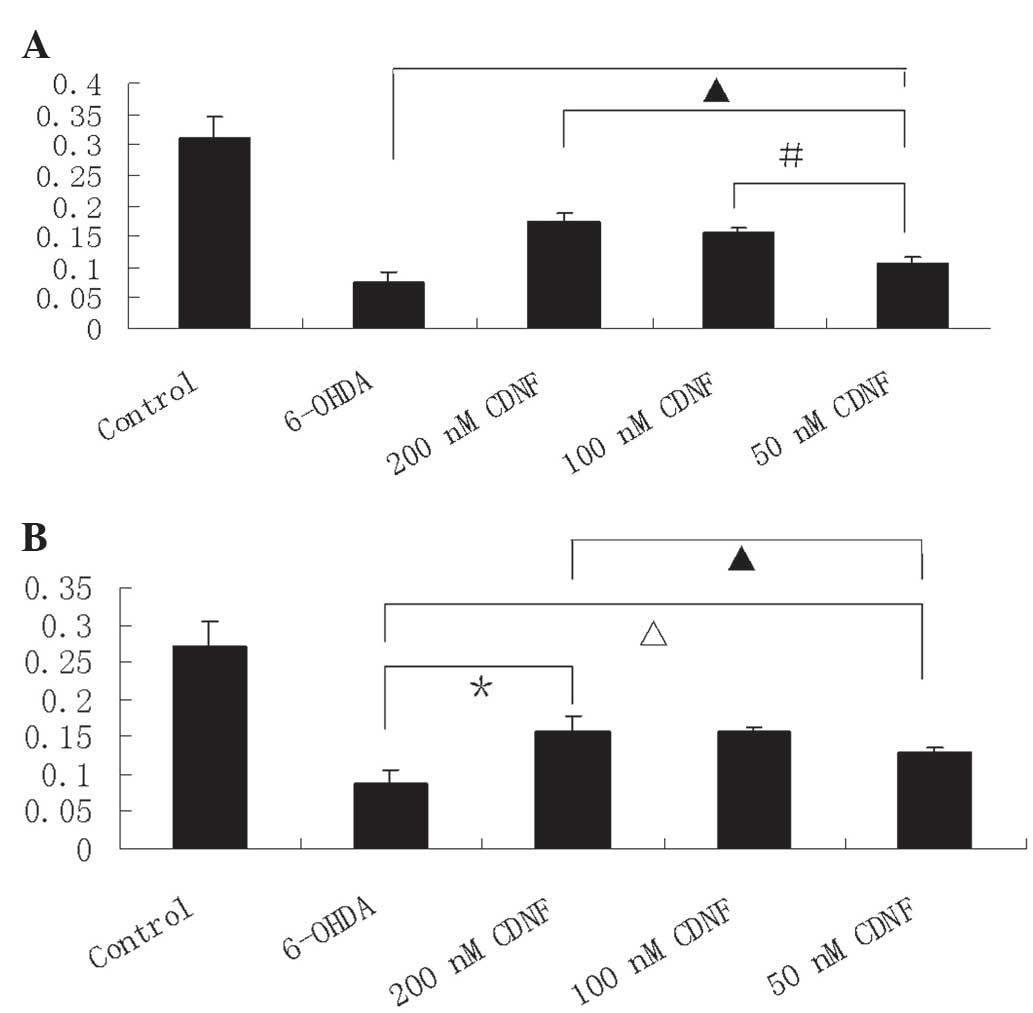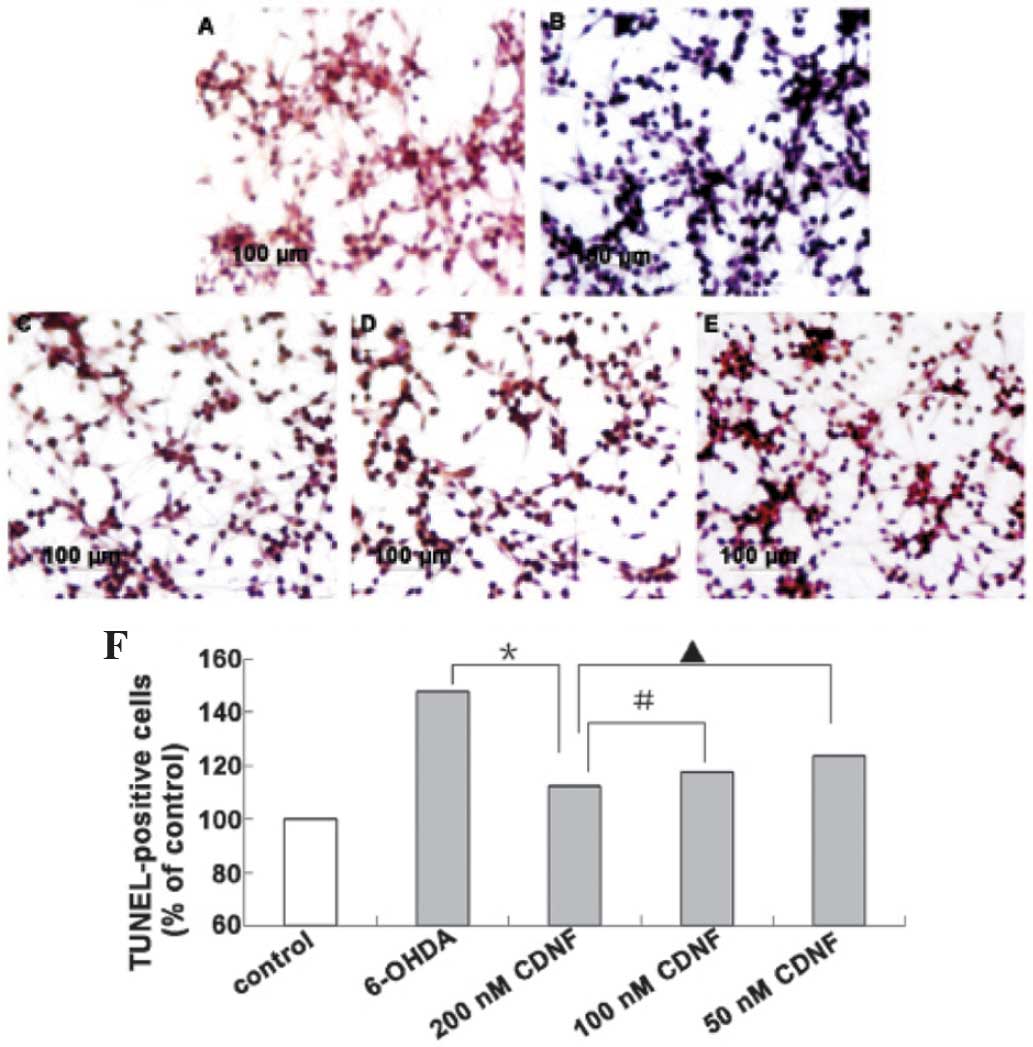|
1
|
Han B, Hu J, Shen J, Gao Y, Lu Y and Wang
T: Neuroprotective effect of hydroxysafflor yellow A on
6-hydroxydopamine-induced Parkinson’s disease in rats. Eur J
Pharmacol. 714:83–88. 2013. View Article : Google Scholar : PubMed/NCBI
|
|
2
|
Airavaara M, Harvey BK, Voutilainen MH, et
al: CDNF protects the nigrostriatal dopamine system and promotes
recovery after MPTP treatment in mice. Cell Transplant.
21:1213–1223. 2012. View Article : Google Scholar
|
|
3
|
Chaturvedi RK and Flint Beal M:
Mitochondrial diseases of the brain. Free Radic Biol Med. 63:1–29.
2013. View Article : Google Scholar : PubMed/NCBI
|
|
4
|
Lopert P, Day BJ and Patel M: Thioredoxin
reductase deficiency potentiates oxidative stress, mitochondrial
dysfunction and cell death in dopaminergic cells. PLoS One.
7:e506832012. View Article : Google Scholar : PubMed/NCBI
|
|
5
|
Cantu D, Fulton RE, Drechsel DA and Patel
M: Mitochondrial aconitase knockdown attenuates paraquat-induced
dopaminergic cell death via decreased cellular metabolism and
release of iron and H2O2. J Neurochem.
118:79–92. 2011. View Article : Google Scholar : PubMed/NCBI
|
|
6
|
Calabrese V, Lodi R, Tonon C, et al:
Oxidative stress, mitochondrial dysfunction and cellular stress
response in Friedreich’s ataxia. J Neurol Sci. 233:145–162. 2005.
View Article : Google Scholar : PubMed/NCBI
|
|
7
|
Prinz A, Selesnew LM, Liss B, Roeper J and
Carlsson T: Increased excitability in serotonin neurons in the
dorsal raphe nucleus in the 6-OHDA mouse model of Parkinson’s
disease. Exp Neurol. 248:236–245. 2013. View Article : Google Scholar : PubMed/NCBI
|
|
8
|
Sadan O, Bahat-Stromza M, Barhum Y, et al:
Protective effects of neurotrophic factor-secreting cells in a
6-OHDA rat model of Parkinson disease. Stem Cells Dev.
18:1179–1190. 2009. View Article : Google Scholar : PubMed/NCBI
|
|
9
|
Olds ME, Jacques DB and Kpoyov O:
Behavioral/neurophysiological investigation of effects of combining
a quinolinic acid entopeduncular lesion with a fetal mesencephalic
tissue transplant in striatum of the 6-OHDA hemilesioned rat.
Synapse. 49:1–11. 2003. View Article : Google Scholar : PubMed/NCBI
|
|
10
|
Offen D, Sherki Y, Melamed E, Fridkin M,
Brenneman DE and Gozes I: Vasoactive intestinal peptide (VIP)
prevents neurotoxicity in neuronal cultures: relevance to
neuroprotection in Parkinson’s disease. Brain Res. 854:257–262.
2000. View Article : Google Scholar : PubMed/NCBI
|
|
11
|
Wang LZ, Sun WC and Zhu XZ: Ethyl pyruvate
protects PC12 cells from dopamine-induced apoptosis. Eur J
Pharmacol. 508:57–68. 2005. View Article : Google Scholar : PubMed/NCBI
|
|
12
|
Chagkutip J, Govitrapong P, Klongpanichpak
S and Ebadi M: Mechanism of 1-methyl-4-phenylpyridinium-induced
dopamine release from PC12 cells. Neurochem Res. 30:633–639. 2005.
View Article : Google Scholar : PubMed/NCBI
|
|
13
|
Lindholm P, Voutilainen MH, Laurén J, et
al: Novel neurotrophic factor CDNF protects and rescues midbrain
dopamine neurons in vivo. Nature. 448:73–77. 2007. View Article : Google Scholar : PubMed/NCBI
|
|
14
|
Voutilainen MH, Bäck S, Peränen J, et al:
Chronic infusion of CDNF prevents 6-OHDA-induced deficits in a rat
model of Parkinson’s disease. Exp Neurol. 228:99–108. 2011.
View Article : Google Scholar
|
|
15
|
Bäck S, Peränen J, Galli E, et al: Gene
therapy with AAV2-CDNF provides functional benefits in a rat model
of Parkinson’s disease. Brain Behav. 3:75–88. 2013. View Article : Google Scholar
|
|
16
|
Ren X, Zhang T, Gong X, Hu G, Ding W and
Wang X: AAV2-mediated striatum delivery of human CDNF prevents the
deterioration of midbrain dopamine neurons in a 6-hydroxy-dopamine
induced parkinsonian rat model. Exp Neurol. 248:148–156. 2013.
View Article : Google Scholar : PubMed/NCBI
|
|
17
|
Gorman AM, Szegezdi E, Quigney DJ and
Samali A: Hsp27 inhibits 6-hydroxydopamine-induced cytochrome c
release and apoptosis in PC12 cells. Biochem Biophys Res Commun.
327:801–810. 2005. View Article : Google Scholar : PubMed/NCBI
|
|
18
|
Stahl K, Mylonakou MN, Skare Ø,
Amiry-Moghaddam M and Torp R: Cytoprotective effects of growth
factors: BDNF more potent than GDNF in an organotypic culture model
of Parkinson’s disease. Brain Res. 1378:105–118. 2011. View Article : Google Scholar : PubMed/NCBI
|
|
19
|
Gyárfás T, Knuuttila J, Lindholm P,
Rantamäki T and Castrén E: Regulation of brain-derived neurotrophic
factor (BDNF) and cerebral dopamine neurotrophic factor (CDNF) by
anti-parkin-sonian drug therapy in vivo. Cell Mol Neurobiol.
30:361–368. 2010. View Article : Google Scholar
|
|
20
|
Gill SS, Patel NK, Hotton GR, O’Sullivan
K, et al: Direct brain infusion of glial cell line-derived
neurotrophic factor in parkinson disease. Nat Med. 9:589–595. 2003.
View Article : Google Scholar : PubMed/NCBI
|
|
21
|
Patel NK, Bunnage M, Plaha P, Svendsen CN,
Heywood P and Gill SS: Intraputamenal infusion of glia cell
line-derived neurotrophic factor in PD: a two-year outcome study.
Ann Neurol. 57:298–302. 2005. View Article : Google Scholar : PubMed/NCBI
|
|
22
|
Lang AE, Gill S, Patel NK, et al:
Randomized controlled trial of intraputamenal glial cell
line-derived neurotrophic factor infusion in Parkinson disease. Ann
Neurol. 59:459–466. 2006. View Article : Google Scholar : PubMed/NCBI
|
|
23
|
Black YD, Xiao D, Pellegrino D, Kachroo A,
Brownell AL and Schwarzschild MA: Protective effect of metabotropic
glutamate mGluR5 receptor elimination in a 6-hydroxydopamine model
of Parkinson’s disease. Neurosci Lett. 486:161–165. 2010.
View Article : Google Scholar : PubMed/NCBI
|
|
24
|
Winner B, Desplats P, Hagl C, et al:
Dopamine receptor activation promotes adult neurogenesis in an
acute Parkinson model. Exp Neurol. 219:543–552. 2009. View Article : Google Scholar : PubMed/NCBI
|
|
25
|
Kwon IH, Choi HS, Shin KS, et al: Effects
of berberine on 6-hydroxydopamine-induced neurotoxicity in PC12
cells and a rat model of Parkinson’s disease. Neurosci Lett.
486:29–33. 2010. View Article : Google Scholar : PubMed/NCBI
|
|
26
|
Kim Y, Li E and Park S: Insulin-like
growth factor-1 inhibits 6-hydroxydopamine-mediated endoplasmic
reticulum stress-induced apoptosis via regulation of heme
oxygenase-1 and Nrf2 expression in PC12 cells. Int J Neurosci.
122:641–649. 2012. View Article : Google Scholar : PubMed/NCBI
|
|
27
|
Li X, Peng C, Li L, Ming M, Yang D and Le
W: Glial cell-derived neurotrophic factor protects against
proteasome inhibition-induced dopamine neuron degeneration by
suppression of endoplasmic reticulum stress and caspase-3
activation. J Gerontol A Biol Sci Med Sci. 62:943–950. 2007.
View Article : Google Scholar : PubMed/NCBI
|















